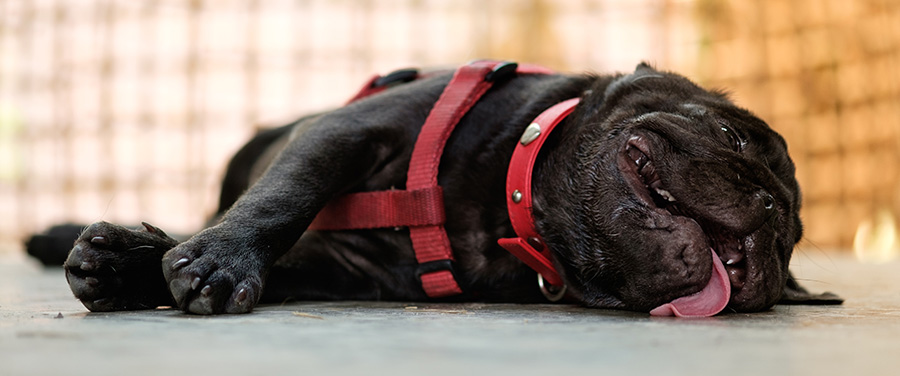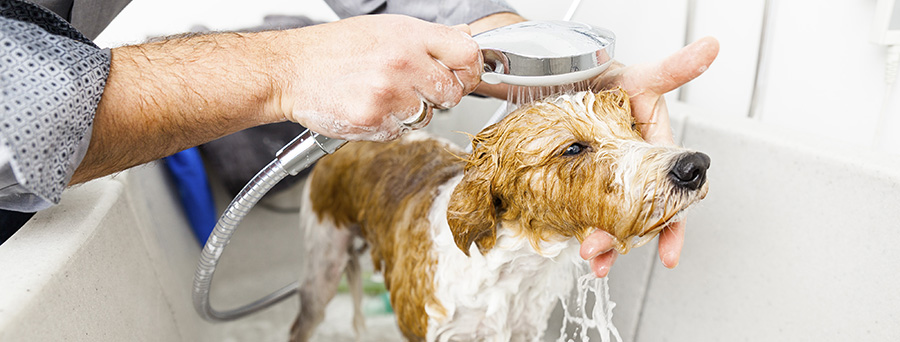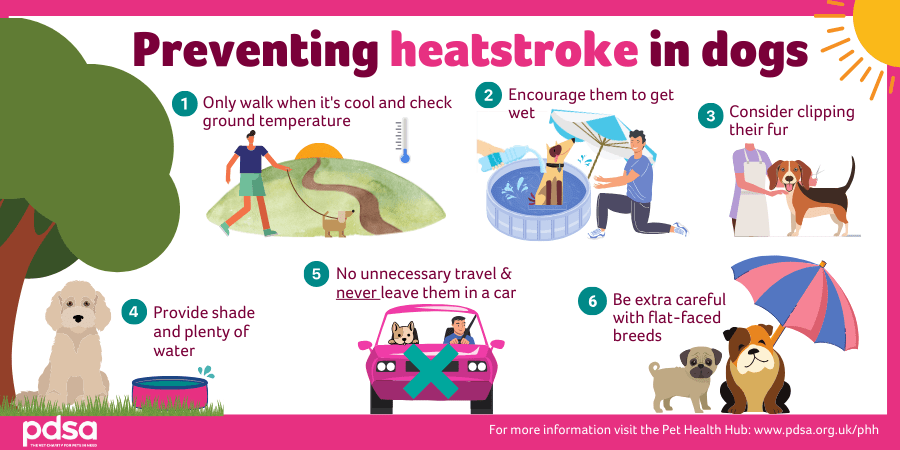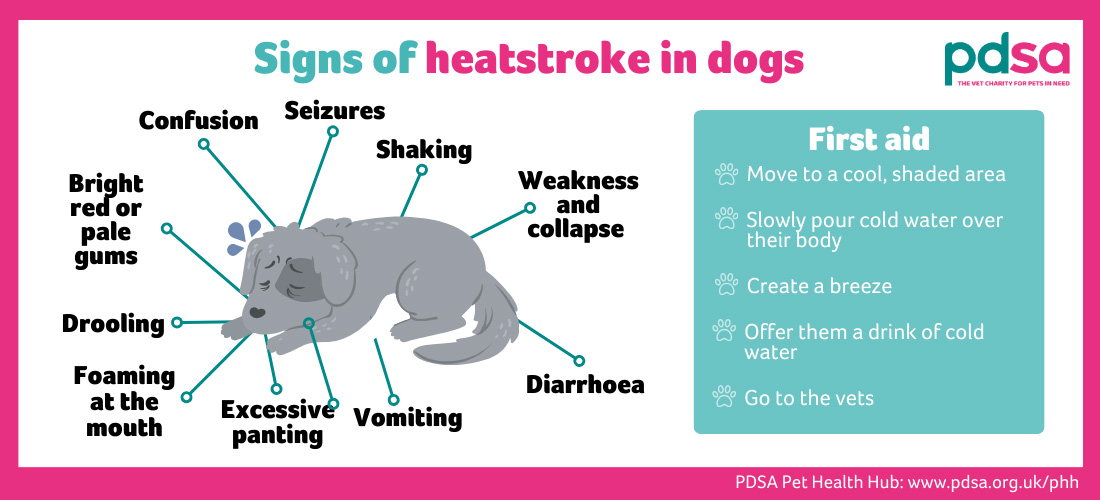Heatstroke in dogs
Overview
- Heatstroke is a very serious condition that can progress very quickly, and in severe cases, cause seizures, organ damage and death.
- Most cases of heatstroke in dogs occur during exercise, but it can also be caused by being trapped somewhere hot, or in some circumstances, just sitting somewhere warm.
- If your dog is showing signs of heatstroke, immediately start first aid. The quicker your dog is cooled down, the better their chance of a full recovery.
- Obese, brachycephalic (flat-faced), young, elderly, giant breed, and long-haired dogs are most at risk of heatstroke.
- It’s important to take precautions to keep your dog safe on warm days.
 Video found at youtu.be/Uf1hsbSnhHo
Video found at youtu.be/Uf1hsbSnhHo
Act quickly but stay calm – the faster your dog cools down the better their of recovery.
Step 1: Move your dog indoors to a cool room or into the shade
Step 2: Cool your dog down straight away
- Gently pour cold water (water from the cold tap is fine) over their whole body
- Start slowly so they don’t panic, but aim to soak their whole body as calmly and quickly as possible.
- Be extremely careful they don’t inhale any water by keeping it away from their nose and mouth
- Alternatively, if they are used to water and won’t panic, you can submerge their whole body (except for their head) into water
- Create a breeze by opening doors and windows or turning a fan/air-con on
- Offer them a drink of cold water but don’t force them to drink if they don’t want to
- Put them on top of a cold wet towel
- Wrap an ice pack/frozen veg in a towel and place it in between their thighs (if they are small, place them on top of it)
- Don’t cuddle them or cover them with a wet towel, as this will make them even hotter
Step 3: Call your vet as soon as possible
- Ideally go to your nearest vets
- Transport them in an air conditioned car/a car with the windows open (but make sure they can’t escape)
- If possible bring someone with you to keep cooling them while you travel

Heatstroke is an extremely dangerous condition that can develop if a dog gets too hot. Normal body temperature for a dog tends to sit between 38-39°C (100.4-102.2°F), this can rise a bit if they are unwell with a fever. If your dog’s body temperature goes above 40°C (104°F) they are at risk of heatstroke, which can cause seizures, organ damage, internal bleeding, coma and even death. Heatstroke is more dangerous the longer it lasts, so the quicker your dog is cooled down and treated by a vet, the better their chance of a full recovery.
Causes of heatstroke in dogs
Dogs have limited ability to sweat, so instead, they pant and use shade to cool themselves down on warm days. However, dogs also love to run around, which is why nearly three quarters of heatstroke cases develop while playing and exercising. It can also be caused by simply sitting somewhere too warm, or being trapped somewhere hot, such as a car, conservatory or room without proper ventilation.
Any dog can develop heatstroke, but flat-faced, overweight, giant-breed, thick-coated, very old and very young dogs are most at risk.

Cooling
Your vet will try to reduce your dog’s temperature as quickly as possible using cold water, fans, and if necessary, a fluid drip. If your dog is extremely hot, struggling to breathe, having seizures, or unconscious, they may also need oxygen, medications, or to be put under anaesthesia.
Medications and tests
Severe heatstroke can cause blood clotting problems, and damage organs such as the kidneys, brain, guts, heart and lungs. If your dog is showing signs of severe heatstroke your vet may need to run some blood and urine tests, put them on a drip to support their organs, and give them medications to prevent any further damage. If this is the case, your dog may need to stay in the hospital for several days.
Nursing
Your dog will be monitored and nursed very carefully until they are stable. Once your dog has stabilised, they will be sent home. You will need to monitor them closely for 24-48 hours, and let your vet know if they deteriorate or develop symptoms such as vomiting, diarrhoea, confusion, or reduced appetite.
Check-ups
It’s likely that your dog will need to be checked a few days after they are discharged to make sure they are continuing to recover well. Your vet may also want to run some repeat blood and urine tests to check their vital organs. If your vet asks you to bring a urine sample in check out our video on how to collect a urine sample from your dog.
Outlook
The quicker your dog is cooled down, the better their chance of a full recovery. If your dog has a mild case of heatstroke, and is cooled/treated quickly, they are likely to make a full recovery. However, if they have a severe case of heatstroke, have already developed organ damage, or treatment is delayed, they are much less likely to recover.

It’s vitally important to protect your dog from heatstroke, especially if they are flat-faced, overweight, or have a thick coat. There are some simple things that you can do to prevent it, such as:
- Walk them when it’s cool: Avoid walking your dog in the hottest part of the day, instead take them out in the early morning/evening when it’s cool. Avoid exercise on hot days completely if your dog is unfit, elderly, young, overweight, unwell, or has breathing difficulties.
- Make sure they always have access to shade and water: It’s a good idea to take water with you on walks – especially on warm days.
- Get them wet on warm days: pour water over your dog, or encourage them into cool water (such as a paddling pool) on hot days. But always make sure they stay in the shade and don’t get too excited as this can still cause them to overheat. Never force your dog into water if they’re scared.
- Use a harness instead of a collar: Attaching a lead to a harness will put less pressure on your dog’s throat, making it easier for them to pant and cool down. This is especially important if your dog has breathing problems, or is brachycephalic (flat-faced). Remember to keep your dog’s collar on even if you are using a harness to walk them – they are a legal requirement.
- Never walk your dog on a hot surface: If you can comfortably place the palm of your hand on it for 7 seconds it’s okay – sand, artificial grass and tarmac get especially hot.
- Never leave your dog in a car on a warm day: Not even for a few minutes, with the windows open, or in the shade.
- Avoid travelling with your dog in a car when it’s hot: If a journey is absolutely necessary, make sure they are in the shade, have air flowing around them and can access drinking water. Cooling mats can be useful when travelling on warm days.
- Keep your dog a healthy weight: Overweight dogs find it more difficult to stay cool.
- Consider having your dog clipped: Especially in the warmer months if they have a heavy coat. Brushing your dog’s fur can also help.
Heatstroke in brachycephalic (flat-faced) dogs
Dogs get rid of a significant amount of body heat through their nose as they breathe out. Brachycephalic (flat-faced) dogs struggle to release heat this way because they have much less space inside their nose, which puts them at a very high risk of heatstroke, even on cool days. British Bulldogs are 14 times more likely to develop heatstroke than Labradors, and Pugs are 6 times more likely! Dogs most affected include the Pug, English Bulldog, French Bulldog, Dog de Bordeaux, Pomeranian, Shih Tzu and Boston Terrier.
Cost
Emergency treatment for a poorly pet can be expensive.
When you welcome a new dog into your life, consider getting dog insurance straight away before any signs of illness start. This will give you peace of mind that you have some financial support if they ever get sick.
Published: September 2023
Did you find this page useful?
Tell us more
Please note, our vets and nurses are unable to respond to questions via this form. If you are concerned about your pet’s health, please contact your vet directly.
Thank you for your feedback
Want to hear more about PDSA and get pet care tips from our vet experts?
Sign up to our e-newsletter
Written by vets and vet nurses. This advice is for UK pets only. Illustrations by Samantha Elmhurst.


